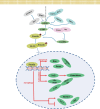The role of Foxo3a in neuron-mediated cognitive impairment
- PMID: 38962803
- PMCID: PMC11220205
- DOI: 10.3389/fnmol.2024.1424561
The role of Foxo3a in neuron-mediated cognitive impairment
Abstract
Cognitive impairment (COI) is a prevalent complication across a spectrum of brain disorders, underpinned by intricate mechanisms yet to be fully elucidated. Neurons, the principal cell population of the nervous system, orchestrate cognitive processes and govern cognitive balance. Extensive inquiry has spotlighted the involvement of Foxo3a in COI. The regulatory cascade of Foxo3a transactivation implicates multiple downstream signaling pathways encompassing mitochondrial function, oxidative stress, autophagy, and apoptosis, collectively affecting neuronal activity. Notably, the expression and activity profile of neuronal Foxo3a are subject to modulation via various modalities, including methylation of promoter, phosphorylation and acetylation of protein. Furthermore, upstream pathways such as PI3K/AKT, the SIRT family, and diverse micro-RNAs intricately interface with Foxo3a, engendering alterations in neuronal function. Through several downstream routes, Foxo3a regulates neuronal dynamics, thereby modulating the onset or amelioration of COI in Alzheimer's disease, stroke, ischemic brain injury, Parkinson's disease, and traumatic brain injury. Foxo3a is a potential therapeutic cognitive target, and clinical drugs or multiple small molecules have been preliminarily shown to have cognitive-enhancing effects that indirectly affect Foxo3a. Particularly noteworthy are multiple randomized, controlled, placebo clinical trials illustrating the significant cognitive enhancement achievable through autophagy modulation. Here, we discussed the role of Foxo3a in neuron-mediated COI and common cognitively impaired diseases.
Keywords: Foxo3a; brain; cognitive impairment; cognitively impaired diseases; neurons.
Copyright © 2024 Liu, Wu, Wang, Xiong, Rui-Wang and Yao.
Conflict of interest statement
The authors declare that the research was conducted in the absence of any commercial or financial relationships that could be construed as a potential conflict of interest.
Figures





Similar articles
-
Inhibition of PTEN Ameliorates Secondary Hippocampal Injury and Cognitive Deficits after Intracerebral Hemorrhage: Involvement of AKT/FoxO3a/ATG-Mediated Autophagy.Oxid Med Cell Longev. 2021 Jan 18;2021:5472605. doi: 10.1155/2021/5472605. eCollection 2021. Oxid Med Cell Longev. 2021. PMID: 33777313 Free PMC article.
-
Nobiletin ameliorates hepatic ischemia and reperfusion injury through the activation of SIRT-1/FOXO3a-mediated autophagy and mitochondrial biogenesis.Exp Mol Med. 2019 Apr 26;51(4):1-16. doi: 10.1038/s12276-019-0245-z. Exp Mol Med. 2019. PMID: 31028246 Free PMC article.
-
HDAC2 selectively regulates FOXO3a-mediated gene transcription during oxidative stress-induced neuronal cell death.J Neurosci. 2015 Jan 21;35(3):1250-9. doi: 10.1523/JNEUROSCI.2444-14.2015. J Neurosci. 2015. PMID: 25609639 Free PMC article.
-
Autophagy and apoptosis cascade: which is more prominent in neuronal death?Cell Mol Life Sci. 2021 Dec;78(24):8001-8047. doi: 10.1007/s00018-021-04004-4. Epub 2021 Nov 6. Cell Mol Life Sci. 2021. PMID: 34741624 Free PMC article. Review.
-
Therapeutic potentials of plant iridoids in Alzheimer's and Parkinson's diseases: A review.Eur J Med Chem. 2019 May 1;169:185-199. doi: 10.1016/j.ejmech.2019.03.009. Epub 2019 Mar 8. Eur J Med Chem. 2019. PMID: 30877973 Review.
Cited by
-
FOXOs and their roles in acute and chronic neurological disorders.Front Mol Biosci. 2025 Apr 7;12:1538472. doi: 10.3389/fmolb.2025.1538472. eCollection 2025. Front Mol Biosci. 2025. PMID: 40260403 Free PMC article. Review.
-
A Transcriptomic Roadmap of Parkinson's Disease Progression at Single Cell Resolution.medRxiv [Preprint]. 2025 Jul 30:2025.07.30.25332436. doi: 10.1101/2025.07.30.25332436. medRxiv. 2025. PMID: 40766144 Free PMC article. Preprint.
-
Interconnection of CD133 Stem Cell Marker with Autophagy and Apoptosis in Colorectal Cancer.Int J Mol Sci. 2024 Oct 18;25(20):11201. doi: 10.3390/ijms252011201. Int J Mol Sci. 2024. PMID: 39456981 Free PMC article. Review.
-
Toxoplasma GRA16 attenuates Tau hyperphosphorylation and enhances autophagy in thrombin-treated HT-22 hippocampal neuronal cells.Sci Rep. 2025 May 20;15(1):17412. doi: 10.1038/s41598-025-00271-4. Sci Rep. 2025. PMID: 40389494 Free PMC article.
References
-
- Ansari M., Al-Jarallah A., Rao M., Babiker A., Bensalamah K. (2024). Upregulation of NADPH-oxidase, inducible nitric oxide synthase and apoptosis in the hippocampus following impaired insulin signaling in the rats: Development of sporadic Alzheimer’s disease. Brain Res. 1834:148890. 10.1016/j.brainres.2024.148890 - DOI - PubMed
Publication types
LinkOut - more resources
Full Text Sources
Research Materials

